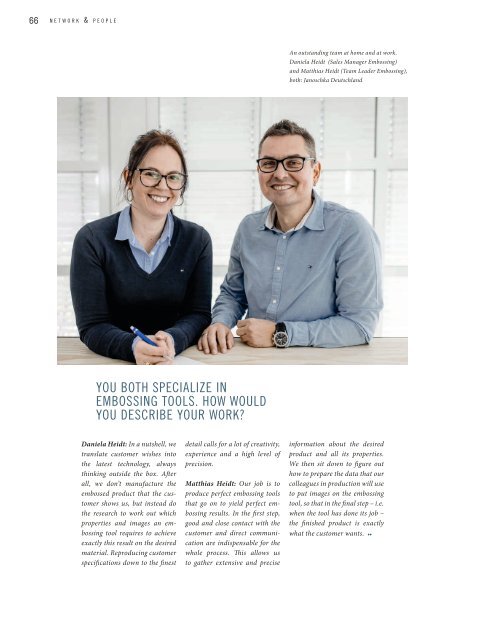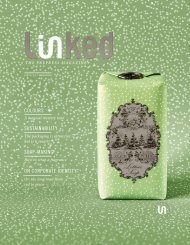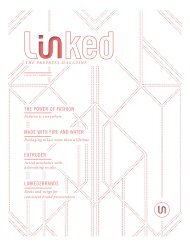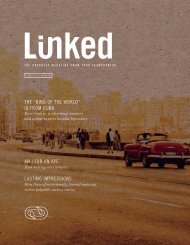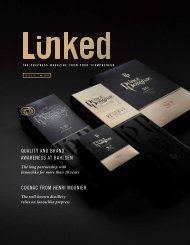Janoschka magazine Linked_V8_2023
The customer magazine by Janoschka and Linked2Brands.
The customer magazine by Janoschka and Linked2Brands.
Create successful ePaper yourself
Turn your PDF publications into a flip-book with our unique Google optimized e-Paper software.
66 n e t w o r k & p e o p l e<br />
issue #8 ©<br />
l i n k e d<br />
67<br />
An outstanding team at home and at work.<br />
Daniela Heidt (Sales Manager Embossing)<br />
and Matthias Heidt (Team Leader Embossing),<br />
both: <strong>Janoschka</strong> Deutschland<br />
SO YOU BRING TOGETHER MANY YEARS OF<br />
EXPERIENCE, TECHNICAL KNOW-HOW<br />
AND EXTENSIVE SPECIALIST KNOWLEDGE?<br />
Matthias Heidt: That's right.<br />
The world of embossing is<br />
huge. You have to imagine<br />
that you can emboss almost<br />
any material. You’ll be familiar<br />
with various types of embossed<br />
paper and cardboard,<br />
like packaging, wallpaper and<br />
paper place mats on restaurant<br />
tables. Cellulose is embossed<br />
to make kitchen roll and toilet<br />
paper. Embossed plastics are<br />
used in car interiors and strapping<br />
band. However, you can<br />
also emboss glass, sheet steel<br />
and composite materials for<br />
façades on spectacular buildings.<br />
Which embossing tool is<br />
used depends on the material.<br />
The technique we use to add<br />
the image to the tool, i.e. either<br />
direct laser, CNC cutting or<br />
etching, depends on the motif:<br />
micro-embossing and intricate<br />
structures are normally produced<br />
using lasers.<br />
YOU BOTH SPECIALIZE IN<br />
EMBOSSING TOOLS. HOW WOULD<br />
YOU DESCRIBE YOUR WORK?<br />
Each task in the embossing process<br />
is complex, owing to the<br />
combination and interaction of<br />
the various aspects: the material,<br />
the different design elements<br />
in the various embossing techniques,<br />
the finest lines and lettering<br />
or designs covering large surfaces –<br />
all of which play a role in achieving<br />
the desired results.<br />
Daniela Heidt: In a nutshell, we<br />
translate customer wishes into<br />
the latest technology, always<br />
thinking outside the box. After<br />
all, we don’t manufacture the<br />
embossed product that the customer<br />
shows us, but instead do<br />
the research to work out which<br />
properties and images an embossing<br />
tool requires to achieve<br />
exactly this result on the desired<br />
material. Reproducing customer<br />
specifications down to the finest<br />
detail calls for a lot of creativity,<br />
experience and a high level of<br />
precision.<br />
Matthias Heidt: Our job is to<br />
produce perfect embossing tools<br />
that go on to yield perfect embossing<br />
results. In the first step,<br />
good and close contact with the<br />
customer and direct communication<br />
are indispensable for the<br />
whole process. This allows us<br />
to gather extensive and precise<br />
information about the desired<br />
product and all its properties.<br />
We then sit down to figure out<br />
how to prepare the data that our<br />
colleagues in production will use<br />
to put images on the embossing<br />
tool, so that in the final step – i.e.<br />
when the tool has done its job –<br />
the finished product is exactly<br />
what the customer wants.<br />
Daniela Heidt: And then there<br />
are all the different reasons<br />
why you might emboss surfaces:<br />
to make them look elegant, to<br />
catch your eye and to feel good<br />
in your hands – just for starters.<br />
The diverse and essential<br />
functions fulfilled by embossed<br />
surfaces are less obvious, but<br />
no less intriguing: on sheet steel<br />
in lifts or on sliding surfaces at<br />
supermarket check-outs, the aim<br />
is to prevent soiling or to make<br />
the surface more slippery or<br />
easier to clean. Embossing<br />
makes labels more elastic and<br />
creates decorative patterns on<br />
tissue products like kitchen roll<br />
and toilet paper, thus strengthening<br />
it and holding the individual<br />
layers together.


